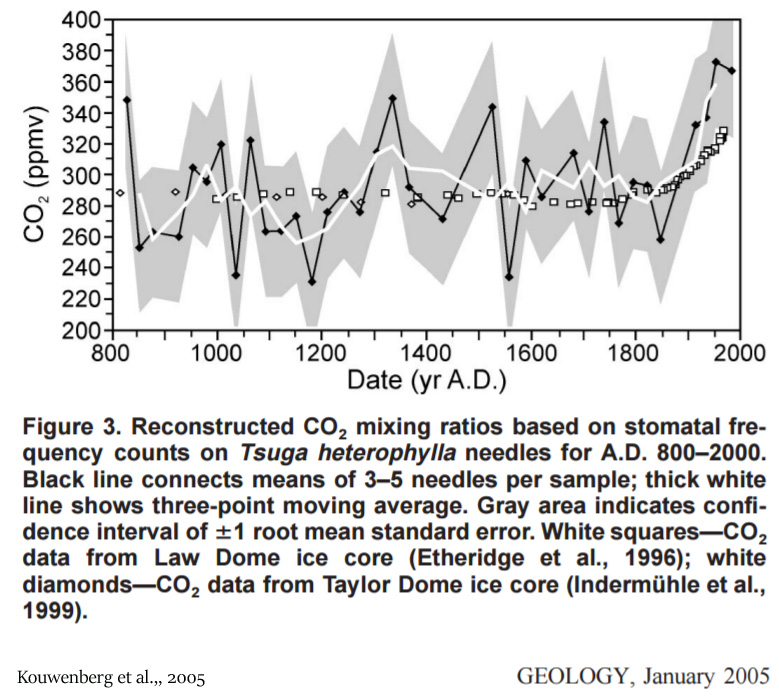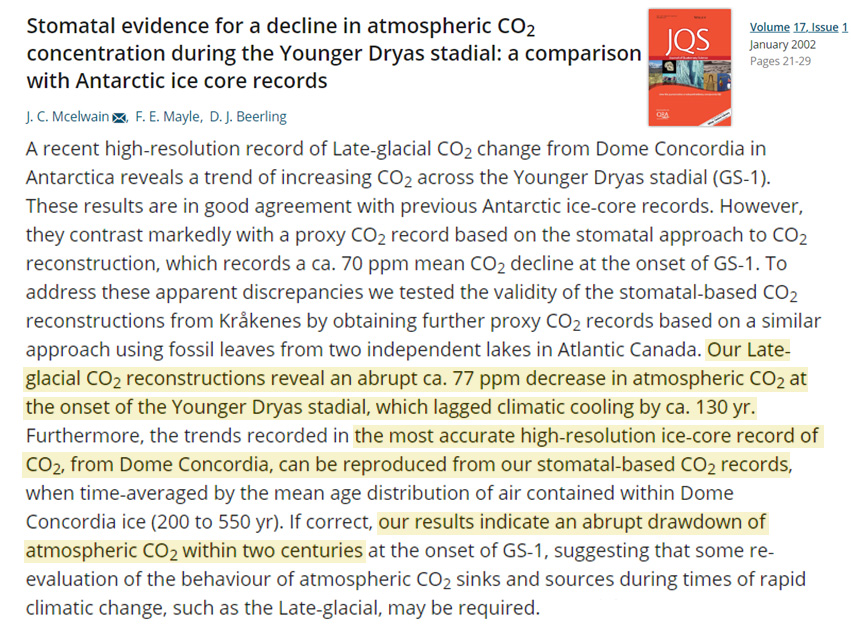CO2 reached 1980s (352 ppm, average) to 2000s (380 ppm, max) levels 2500-5500 years ago in Japan per stomata records.
Scientists (Wang et al., 2020) have determined stomatal evidence can uncover large short-term CO2 fluxes of 50-100 ppm within a century or less.
Measurements from a forest near Mt. Kurikoma, Japan, reveal minimum to maximum CO2 values ranged between 288 ppm (minimum) to 383 ppm (maximum) between 3,903 to 3,795 cal. yr BP. The region’s sea surface temperatures were 1-2°C warmer (23-24°C) than today (22°C) from about 4,000 to 5,500 years ago.

Image Source: Wang et al., 2020
Other reconstructions have also determined CO2 fluctuates far more rapidly in stomatal records than in the records divined from bubbles in old ice. For example, CO2 rose from about 260 to 380 ppm during the century between 1850 and 1950 (Kouwenberg et al, 2005) and declined by 77 ppm in <200 years (Mcelwain et al., 2002) during the Younger Dryas abrupt cooling event per evidence from stomata.

Image Source: Kouwenberg et al, 2005






This shows how technologically advanced Japan was even 4,000 years ago.
Sure were…
https://www.dailymotion.com/video/x3o8i1u
I would think that leaf stomata are a more reliable method of tracking CO2 through history than measurements of CO2 in ice cores.
It occurs to me that it would be nice if there were any correlation between tree ring data and stomata at various temperatures and humidities. Are you aware of any papers looking at those variables, Kenneth? I’m thinking contemporary, to establish a baseline database. I can’t image that someone hasn’t looked at that, or some permutations of those variables, to establish a reference point from which to interpret data on samples from the past.
[…] New glyphosate papers point to “urgency” for more research on chemical impact to human health New Study Finds CO2 Reached 1980s-2000s Levels About 4,000 Years Ago In Japan On Coronavirus, We Must Not Allow Politics to Dictate Science | Ron Paul Parabens in urine of […]
The above CO2 Vs time data is amazing. Atmospheric CO2 in the last 1200 years as been as high as 350 ppm, in fact it has been as high as 350 ppm three times, in the last 1200 years.
The stomata analysis to determine past levels of CO2 is completely in agreement, with the past CO2 atmospheric levels determined from high resolution ice core data.
Two independent data sources disprove, the two fundamental concept that are required for AGW. AGW has been disproved.
Atmospheric CO2 is tracking planetary temperature not anthropogenic CO2 emissions.
Humlum et al came to the same conclusion comparing direct recent measurements of global temperature, atmospheric CO2 levels, and anthropogenic emissions Vs time.
They found:
“Summing up, our analysis suggests that changes in atmospheric CO2 appear to occur largely independently of changes in anthropogenic emissions. A similar conclusion was reached by Bacastow (1976), suggesting a coupling between atmospheric CO2 and the Southern Oscillation.
However, by this we have not demonstrated that CO2 released by burning fossil fuels is without influence on the amount of atmospheric CO2, but merely that the effect is small compared to the effect of other processes.
Our previous analyzes suggest that such other more important effects are related to temperature, and with ocean surface temperature near or south of the Equator pointing itself out as being of special importance for changes in the global amount of atmospheric CO2.”
https://www.researchgate.net/publication/257343053_The_phase_relation_between_atmospheric_carbon_dioxide_and_global_temperature
[…] New Study Finds CO2 Reached 1980s-2000s Levels About 4,000 Years Ago In Japan […]